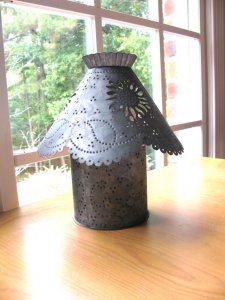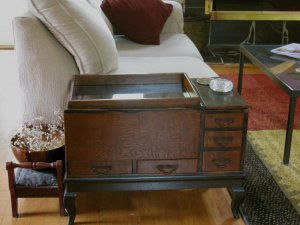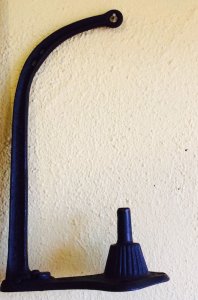You are close, Lara...it is used to warm parts of your body...below the knees.....oh yeah, and it's a couple of feet wide.Used below your knees? Is it like a Japanese type of warmer where you would put hot coals in the drawer and put it a sunken spot where peoples legs are like under a table??
You are using an out of date browser. It may not display this or other websites correctly.
You should upgrade or use an alternative browser.
You should upgrade or use an alternative browser.
Name These Obsolete Technologies
- Thread starter Lara
- Start date
Lara, you have been declared the winner! Yes, it is a foot warmer!
FOOT WARMERS
"Before the mid-1800s, American homes and public spaces were often poorly heated. One device that helped early Americans keep warm was the foot warmer - a box with holes poked in the sides and a tray inside for hot coals. A metal handle or rope allowed the user to transport the warmer easily.
In the 17th, 18th, and early 19th centuries, women and children carried foot warmers to meetings or to church. Women's long skirts would hang over the foot warmer, holding in the precious heat - an excellent use for these seemingly impractical garments.
Although improvements in heating occurred in the 1820s, foot warmers continued to be used in sleighs and carriages. In the late 1800s and early 1900s, heated concrete blocks were used as foot warmers in automobiles.
Foot warmers were made of wood, tin, brass, or a combination of these materials. The holes punched into wood and tin foot warmers often formed a pattern or design.
This example from the METC collection is likely from the late 1700s or early 1800s. Made of wood and tin, it has a sliding front panel that reveals a metal tray for the hot coals. Ventilating holes in the sides form decorative patterns, three of which depict a bird with a heart carved in its center. Popular in early America as wedding gifts, foot warmers were commonly decorated with hearts. The presence of both birds and hearts on this foot warmer is reminiscent of the use of hearts, birds, and flowers by German immigrant artists in Pennsylvania who worked in the Fraktur style. Yet hearts also appear in combination with the Federal eagle in early US folk art".
Lori Beth Finkelstein
FOOT WARMERS
"Before the mid-1800s, American homes and public spaces were often poorly heated. One device that helped early Americans keep warm was the foot warmer - a box with holes poked in the sides and a tray inside for hot coals. A metal handle or rope allowed the user to transport the warmer easily.
In the 17th, 18th, and early 19th centuries, women and children carried foot warmers to meetings or to church. Women's long skirts would hang over the foot warmer, holding in the precious heat - an excellent use for these seemingly impractical garments.
Although improvements in heating occurred in the 1820s, foot warmers continued to be used in sleighs and carriages. In the late 1800s and early 1900s, heated concrete blocks were used as foot warmers in automobiles.
Foot warmers were made of wood, tin, brass, or a combination of these materials. The holes punched into wood and tin foot warmers often formed a pattern or design.
This example from the METC collection is likely from the late 1700s or early 1800s. Made of wood and tin, it has a sliding front panel that reveals a metal tray for the hot coals. Ventilating holes in the sides form decorative patterns, three of which depict a bird with a heart carved in its center. Popular in early America as wedding gifts, foot warmers were commonly decorated with hearts. The presence of both birds and hearts on this foot warmer is reminiscent of the use of hearts, birds, and flowers by German immigrant artists in Pennsylvania who worked in the Fraktur style. Yet hearts also appear in combination with the Federal eagle in early US folk art".
Lori Beth Finkelstein
Lara
Friend of the Arts
- Location
- Mid-Atlantic Coast
Wow, that was a wild guess but based on my experiences in Japan when I think they used hibachi's for that…but didn't look like the one you posted. It would be so pretty to see the glow coming out the little holes. I have a hole-punched tin lantern that holds a candle. So, I just took this pic of it. Just added a pic of my Hibachi from Japan (quite large as you can see). I put glass over the top to make as an end table but inside is a copper lining where they put the coal sticks (not the type of hibachi for cooking) . Sometimes they would put a tea kettle on top and different teas in the drawers but other times they would put in under the center of the table in a hole to warm people's legs. Sorry the pics are so large.




Lara
Friend of the Arts
- Location
- Mid-Atlantic Coast
Yes you are! Hmmm…thinking….is it a part to something or is it fully functional on it's own?
Lara
Friend of the Arts
- Location
- Mid-Atlantic Coast
Good guess! I was thinking paper towel holder after the clue but decided no. Good post Hanfonius.
Now, umm, is this next one a tool that a cobbler or a carpenter would use?
Now, umm, is this next one a tool that a cobbler or a carpenter would use?
Lara
Friend of the Arts
- Location
- Mid-Atlantic Coast
Well, it's probably not a torture device. Ohhh, it's you're clever connection to Hillary's nemesis? An early version of a paper shredder?
Lara
Friend of the Arts
- Location
- Mid-Atlantic Coast
hmm, communication for someone in early 1800's law enforcement…hmm…anyone else have a guess? I'm still thinking…bbl
Yes, Nancy, it makes a noise when whirled around.....so far so good.....If you whirl that thing around with the handle it looks like it would make a clicking noise because of those gears.
OK, so law enforcement and communication in 1800's. This was the early version of 911. Every household had one of these and when the burglars came they would hold this thing out the window and spin it, and hope the next door neighbor would hear it and come running?
This is a Watchman's Rattle. Before towns had formal police forces, they had watchmen. You are close enough to be declared a winner!
This rattle, a recent Museum acquisition, would have been used by a 19th-century watchman in a town without a police force or the means for rapid communication in case of an emergency.
Although many American counties had sheriffs during the colonial era, it was not until the mid-1800s that cities, and later towns, formed police departments. Morris County's first sheriff took office in 1739, a year after the county was created, but Madison did not have its own police department until the 1890s.

Without a police force, towns relied on hired watchmen to walk their streets, especially at night. A watchman would have used a noisemaker much like the one shown here to alert people in the case of an emergency.
This very nicely made rattle, a gift of Theodore Trowbridge of Madison, is crafted from what appears to be cherry wood. Unusual in that the clackers and the frame that support them are carved from one piece of wood, the rattle has a nicely lathe-turned handle.
All in all, this is a very attractive piece of woodworking for a utilitarian object.
[FONT=Arial, Helvetica]Lori Beth Finkelstein[/FONT][FONT=Arial, Helvetica]
[/FONT]
This rattle, a recent Museum acquisition, would have been used by a 19th-century watchman in a town without a police force or the means for rapid communication in case of an emergency.
Although many American counties had sheriffs during the colonial era, it was not until the mid-1800s that cities, and later towns, formed police departments. Morris County's first sheriff took office in 1739, a year after the county was created, but Madison did not have its own police department until the 1890s.

Without a police force, towns relied on hired watchmen to walk their streets, especially at night. A watchman would have used a noisemaker much like the one shown here to alert people in the case of an emergency.
This very nicely made rattle, a gift of Theodore Trowbridge of Madison, is crafted from what appears to be cherry wood. Unusual in that the clackers and the frame that support them are carved from one piece of wood, the rattle has a nicely lathe-turned handle.
All in all, this is a very attractive piece of woodworking for a utilitarian object.
[FONT=Arial, Helvetica]Lori Beth Finkelstein[/FONT][FONT=Arial, Helvetica]
[/FONT]
Not to get off topic, but I discovered this interview, concerning the book: "The Watchman's Rattle" by Rebecca Costa, concerning our ability to solve today's complex problems.
No, but the new version is on Ask This Old House, called "What Is It"!Interesting. I hope it's loud.
Does anyone remember an old TV quiz type show where someone would bring an object and 4 panelists had to guess what it was. I can't remember the name. I loved that show.
Lara
Friend of the Arts
- Location
- Mid-Atlantic Coast
YAY Nancy! I was going to guess again but I was wayyyy off. Just got home but had my stellar answer ready (wrong again robin lol) before seeing your conversation. I was going to say an embosser where you thread the paper through the slat and turn the handle sending the paper through a stamp. Interesting device and background history!
This is a Watchman's Rattle. Before towns had formal police forces, they had watchmen. You are close enough to be declared a winner!
This rattle, a recent Museum acquisition, would have been used by a 19th-century watchman in a town without a police force or the means for rapid communication in case of an emergency.
Although many American counties had sheriffs during the colonial era, it was not until the mid-1800s that cities, and later towns, formed police departments. Morris County's first sheriff took office in 1739, a year after the county was created, but Madison did not have its own police department until the 1890s.

Without a police force, towns relied on hired watchmen to walk their streets, especially at night. A watchman would have used a noisemaker much like the one shown here to alert people in the case of an emergency.
This very nicely made rattle, a gift of Theodore Trowbridge of Madison, is crafted from what appears to be cherry wood. Unusual in that the clackers and the frame that support them are carved from one piece of wood, the rattle has a nicely lathe-turned handle.
All in all, this is a very attractive piece of woodworking for a utilitarian object.
Lori Beth Finkelstein
Could also be used to welcome in the New Year....


